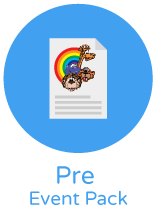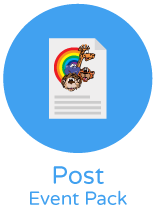You’ve planned your event/activity, the date is set and the next thing you need to do is tell people about it. It’s always possible get some publicity and get the word out there without spending money – or squeezing as much value from the little money you have?
Here are some tips that will help get some more backsides on seats, people through the gate at your next function or more sponsorship towards your goal. These are only the start. You should use this as a base and see how many other ideas you can add to it.
1. Word of Mouth
The first place to start is with your members and supporters. Use your meetings, regular communications and contacts list to let them know about an event and encourage them to tell their friends and friends of friends. Word of mouth is still one of the most powerful selling tools because it also comes with a reliable, credible endorsement.
2. Sell the tickets – collect sponsorship
Even better, get the people who are spreading the word to carry books of tickets or sponsorship forms so that the transaction can be completed in one simple operation. If you do this you’ll have to make regular checks to see who’s sold how many, in order to calculate how many tickets remain and ensure the money comes in. For sponsorship, try and collect the money at first point of contact. It’s easier than chasing payment, post event or activity.
3. Email bulletin
Make sure you have your members/supporters/ business partners on email and send a mass email to let them know about the event/activity (where, when, why, cost, RSVP etc). This is a very cheap form of communication; it ensures people are notified instantly, and that they can easily pass on the message to others they think might be interested. You can issue a reminder but don’t misuse this power to badger people continually – that’s known as spamming.
4. Let your email market your event
Add a paragraph to your email signature to let people know about an upcoming event. Try something like: “Don’t forget the Noah’s Ark Charity Dinner, at the Sandy Village Palladium on May 1, featuring The Three Tops and Madgedonna. All proceeds will go towards medical equipment for the Noah’s Ark Children’s Hospital for Wales. For further information, please call Tina on 9999 999999 or email goodcause@goodcause.
5. Posters, Signs and Shop Windows
For locally-based events, whether a fete or a garage sale – use the old tried and true poster. Most shops will display your information in their window, if you ask politely. We can provide logos and templates to make production easier. (NB: Many local councils have a zero-tolerance policy on posters on council or public property, so make sure you check first before putting a poster up on public property.) It’s etiquette to go round after the event and take them down.
6. Other people’s space
The general rule is “Why not ask if you can get it for free?” Some advertising agencies will do socially responsible work occasionally. Because the bigger advertising agencies spend so much with media organisations, they can sometimes call on favours for space for something they support.
7. Other people’s mail and newsletters
Why not ask for a free ride? Approach local businesses that do regular mailouts and ask if they would mind dropping in an extra sheet advertising your event or provide you with some space in their newsletter. It also provides another option for businesses that are unable to support your group financially.
8. News – Newspapers
Newspapers are always looking for ‘news’ to fill their pages, so with the right pitch and plenty of time you should be able to get an article in. Send them a press release as far in advance as possible, with professionally prepared photos and letterhead. Your release should not be written like an advertisement. It must be written concisely, be newsworthy, be of interest to the public, and be informational (not overtly promotional). If your fundraising was inspired as the result of a relative, colleague or friend’s child receiving treatment or you want to fund a particular department/piece of equipment, don’t forget to mention this.
9. News – TV & Radio
Send your media release to local radio stations as well – for both news and also for an interview. As with the newspapers, you should not be just looking for one run. Be greedy and aim for multiple appearances. The problem with TV news is that they need footage to illustrate their story and so tend to report on things that have already happened rather than things that you
want to happen. Unless you’ve actually involved the network as a sponsor, you are going to have to work hard to get the cameras involved and that means setting up a “picture opportunity” or TV stunt that is so spectacular, so colourful, so active and so much fun that they can’t resist.
10. Online
Put the details of your event on your website and make sure you send through your information to us, as well as any other “What’s On” or free online events listings that are available to you. Facebook, Instagram and Twitter are just a few Social Media platforms, upon which you can spread the work further. Encourage your followers to share your information and don’t forget to ask us to do the same thing!
The Noah’s Ark Children’s Hospital Charity was set up in May 2000 to raise the money needed to build, equip and support the first dedicated children’s hospital for Wales which welcomed its first patient in February 2005. Phase Two opened in May 2015.
Among the projects funded by the charity in Phase Two of the hospital are the hydrotherapy pool, an MRI scanner, dedicated paediatric operating theatres and a new critical care unit.
A video, introduced by Noah’s Ark Patron Charlotte Church, showing the inside of the hospital can be viewed at www.noahsarkcharity.org
Key specialisms at Wales’ national children’s hospital
The Noah’s Ark Children’s Hospital for Wales is home to a wide range of specialties, including the following:-
- General paediatrics
- Surgery
- Respiratory medicine
- Diabetes & endocrinology
- Gastroenterology
- Metabolic medicine
- Neurology
- Neurosurgery
- Nephrology
- Cardiology
- Haematology
- Oncology
- Palliative care
- Intensive care
- Neonatology
- ENT
- Ophthalmology
- Trauma & orthopaedics
Patient visits per year
We provide tertiary care to most of south and mid Wales, plus secondary care to patients within Cardiff and the Vale of Glamorgan. The hospital is expected to admit approximately 23,000 inpatients and 50,000 outpatients per year from across mid, south and west wales.
Clinics across Wales
Our clinicians run over 400 clinics in local hospitals across Wales every year.










